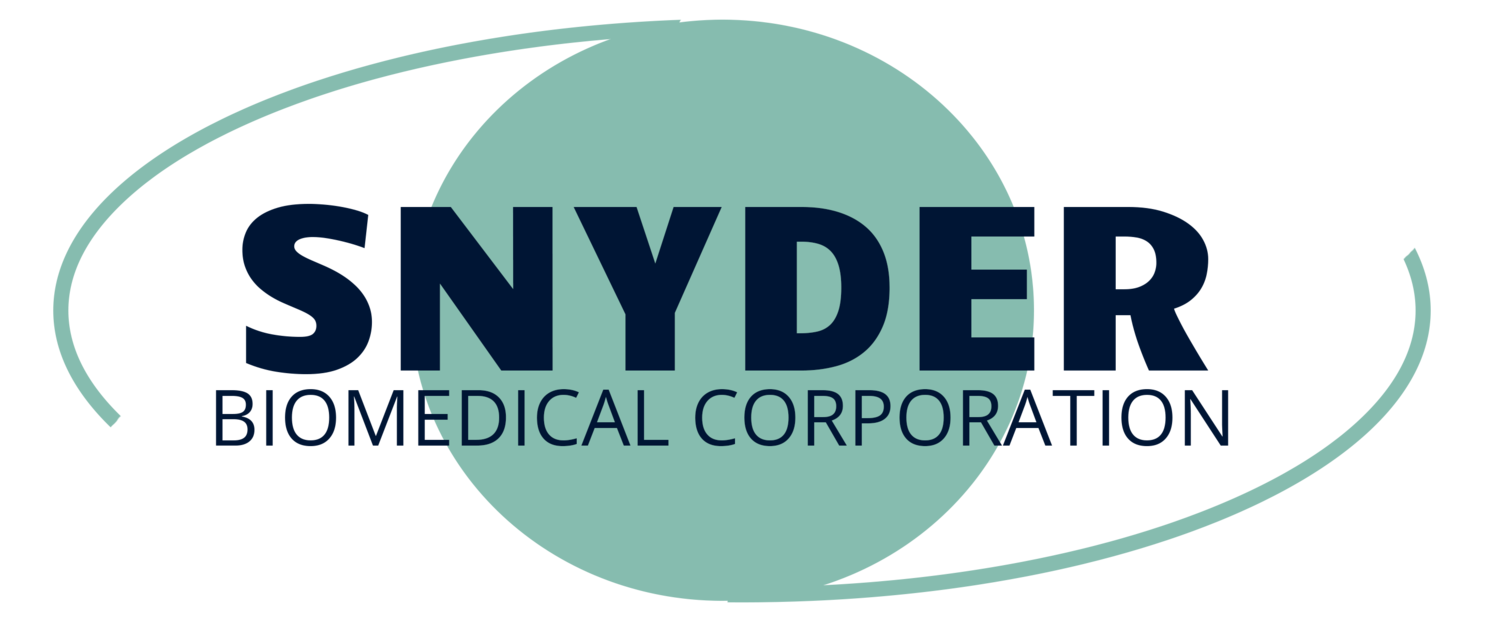INNOVATION FOR NEW THERAPIES TO SAVE VISION
About Us
Snyder Biomedical Corporation was incorporated in 2008 by Robert W. Snyder, MD, PhD, an ophthalmologist and cell biologist, and John A. Martens, a chemical engineer, chemist, and inventor. Each of their careers have been marked by innovation. As such, Snyder Biomedical was formed with the goal of identifying potential therapies to treat and prevent blinding eye disease.
“INNOVATION IS THE KEY TO UNLOCKING THE POWER OF KNOWLEDGE.”
— dR. ROBERT W. SNYDER
Research history
Research data and patents
Age related macular degeneration is the leading cause of blindness in developed countries and the costliest disease among Medicare B beneficiaries in the United States. Most of the vision loss attributed to AMD occurs in wet or neovascular AMD (nAMD) where new blood vessels form under the retina and leak fluid, which disrupts the anatomy and function of the overlying retina. nAMD results in part from excess vascular growth factor (VEGF) secreted from retinal pigment cells (RPE). Currently, it is treated with anti-VEGF drugs injected directly into the eye. In most patients, these injections result in decreased fluid leakage from the subretinal neovascular lesions and improved vision. Unfortunately though, these anti-VEGF injections need to be repeated in most patients every one to two months and are very costly.
In 2008, the McKay Lab at the University of Arizona under the leadership of Dr. Brian McKay, a colleague of Dr. Snyder’s, de-orphaned GPR143, a cell surface receptor on RPE cells and the product of the Ocular Albinism 1 gene. Dr. McKay discovered that L-DOPA, an intermediate in the pigmentation synthesis pathway of RPE cells, was the definitive ligand for GPR143. He found that when L-DOPA binds GPR143 on the RPE cells it causes a decrease in the release of VEGF. He hypothesized that L-DOPA acts in a paracrine manner to modulate VEGF release from the RPE. Drs. McKay and Snyder then speculated that L-DOPA could be used as an adjunct in the treatment of nAMD to reduce the need for injections or delay the development of nAMD in eyes at risk. In a “proof of concept “ clinical trial we treated 20 patients newly diagnosed with nAMD and naive to injection with L-DOPA/carbidopa. A majority of the 17 patients who completed one month of the study had decreased intra and subretinal fluid, decreased central retinal thickness, and improved vision in response to L-DOPA. In a second trial of L-DOPA as an adjunct in patients currently being treated with anti-VEGF agents, we found an improvement in vision after starting L-DOPA and a 51% decrease in the number of injections as compared to the previous year.
We are now preparing a placebo controlled phase 2 clinical trial to determine if L-DOPA can prevent the development of nAMD in high-risk eyes. The expected benefits of treatment with L-DOPA are a reduction in total vision loss from nAMD, reduction of associated treatment costs, and support for individuals with nAMD. In addition, if we reduced the injections by 50% we would save Medicare over $4billion a year based on 2018 utilization.
In 2009, Snyder Biomedical licensed the intellectual property from The University of Arizona and has participated with Dr. McKay in developing L-DOPA as a new treatment for macular degeneration.
At present, Snyder Biomedical continues their research into L-DOPA and macular degeneration. We are continuing development of data and pursuing a pharmaceutical partner.
For more reading about Snyder Biomedical’s accomplishments and work, please see the links below.
Snyder Biomedical holds a patent for a new therapeutic approach to preventing and treating macular degeneration via the stimulation of RPE Cell GPR-143. Learn more >
2019 ARVO Annual Meeting Abstract: Short Term Effects of Carbidopa-Levodopa in Neovascular AMD Learn more >
2019 ARVO Annual Meeting Abstract: Circadian Patterns of Secretion of VEGF by RPE Learn more >
Snyder Biomedical completed a proof of concept trial for their new therapeutic approach to preventing and treating macular degeneration. Their findings were published in the American Journal of Medicine in 2020. Learn more >
In 2022, Dr. Snyder was awarded Honorable Mention in the Winning Pitch Challenge held at the Eyecelerator preceding the American Academy of Ophthalmology’s annual meeting with his Pitch Deck. Learn more >
Methods and Compositions for Treating and Identifying Compounds to Treat Age-Related Macular Degeneration Treatment (US20160015665A1) Learn more >
Compositions and methods for treating or limiting development of age-related macular degeneration (WO2020160256A1) Learn more >
11 million
As many as 11 million people in the United States have some form of age-related macular degeneration. This number is expected to double to nearly 22 million by 2050.
$343 billion
Estimates of the global cost of visual impairment due to age-related macular degeneration is $343 billion, including $255 billion in direct health care costs.
40%
The chance of developing Age-related Macular Degeneration after 80 years old is over 40%.
Contact Us
If you have interest in collaborating with us, fill out the form below.


